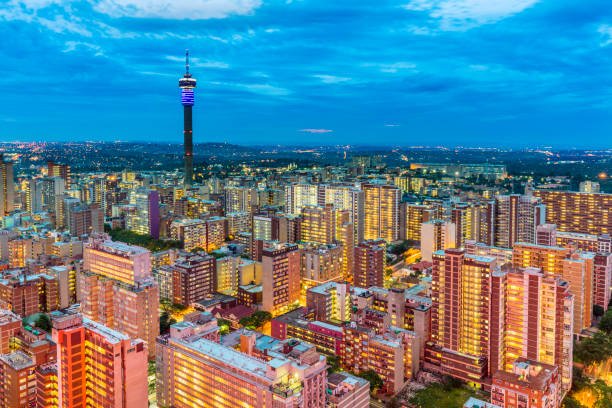On this page we describe the settlement and the different types of land use in Johannesburg:
Settlement geography, the study of human land use, population distribution, and the spatial organization of human activities, plays a pivotal role in understanding the dynamic landscape of a city like Johannesburg. As the largest city in South Africa, Johannesburg offers a rich and complex tableau of human settlement patterns, influenced by historical, political, economic, and social factors. Examining the city through the lens of settlement geography provides insights into the mechanisms shaping the city’s growth and transformation, as well as the disparities that exist within it.
A key attribute of Johannesburg is its unique history, with its roots as a 19th-century gold-mining settlement, which has deeply influenced its settlement patterns. This history, coupled with the legacy of apartheid, has created a city that juxtaposes affluent suburbs with informal settlements and vibrant business districts with expansive industrial zones. Studying the geography of these settlements aids in understanding the city’s past, assessing its present, and projecting future development trajectories.
Studying settlement geography in the context of Johannesburg is also essential because of the city’s role as a major economic hub in Africa. Analysis of its land use patterns, spatial distribution of industries, and the connectivity between different areas allows for better planning and policy-making. Such understanding can help address urban challenges such as inequality, infrastructure development, housing, and environmental management. Ultimately, settlement geography provides a framework for comprehending the multifaceted and evolving nature of Johannesburg, making it an indispensable tool in shaping the city’s future.
Johannesburg, the largest city in South Africa, boasts a diverse and dynamic urban landscape. Since its founding in 1886 following the discovery of gold, the city’s settlement patterns and land use have evolved significantly, shaped by historical, political, and economic factors.
The Settlement and the Different Types of Land Use in Johannesburg
The settlement and the different types of land use in Johannesburg, South Africa’s largest city, are diverse and reflect its complex history. Residential areas range from upscale neighborhoods in the northern suburbs like Sandton and Houghton, to lower-income neighborhoods and informal settlements in the southern and western suburbs, such as Soweto. Commercial and business activities are prominent in the Central Business District and have also expanded into areas like Sandton, which hosts the Johannesburg Stock Exchange and many multinational corporations. The city includes industrial zones in its eastern and southern parts, such as City Deep and Heriotdale, with manufacturing and logistics operations. Johannesburg is also known for its significant urban forest and green spaces, including the Johannesburg Botanical Garden and the Melville Koppies. Additionally, the landscape of the city features mine dumps, remnants of its gold mining history. Each of these elements contributes to the diverse land use and settlement patterns observed in Johannesburg.
Residential Areas
Johannesburg’s residential areas display vast disparities, a reflection of South Africa’s history of segregation under apartheid. In the northern suburbs, like Sandton and Houghton, you’ll find upscale neighborhoods with luxury homes and gated communities, often characterized by large properties and tree-lined streets.
In contrast, Johannesburg’s southern and western suburbs are home to lower-income neighborhoods and informal settlements or townships, such as Soweto, which was a significant site in the struggle against apartheid. While some parts of these townships have seen development, others still struggle with issues such as overcrowding and inadequate access to services.
Commercial and Business Districts
The Central Business District (CBD) was traditionally the heart of Johannesburg’s commercial and business activities. It houses a number of office buildings, retail outlets, and local markets. However, due to urban decay and crime in the late 20th century, many businesses moved north to areas like Sandton, now known as “Africa’s Richest Square Mile.” Sandton has become a significant financial hub, hosting multinational corporations, high-end shopping malls, and the Johannesburg Stock Exchange.
Industrial Zones
Johannesburg has several industrial zones located primarily in the eastern and southern parts of the city. These areas, including City Deep and Heriotdale, host manufacturing plants, warehouses, and logistic operations. The City Deep Container Terminal is a significant hub in Johannesburg’s supply chain, recognized as the largest dry port in the world.
Recreational and Green Spaces
Despite its urban character, Johannesburg is known as one of the world’s largest urban forests, with over six million trees. The city hosts several parks and green spaces, such as the Johannesburg Botanical Garden and the Melville Koppies, a nature reserve and heritage site. These areas provide recreational opportunities for residents and help to improve the city’s air quality.
Mining Landscapes
Gold mining has significantly influenced Johannesburg’s land use. While active mining has decreased, the city’s landscape still bears the marks of this industry in the form of mine dumps. Some of these areas, like the Ferreira’s Mine Dump, have been rehabilitated and redeveloped into spaces for commercial use.
Johannesburg displays a variety of land uses, reflecting the city’s complex history and its growth as a major African metropolis. The city continues to evolve, driven by ongoing development, urban renewal projects, and efforts to redress historical inequalities in land use.






